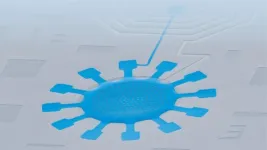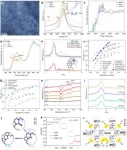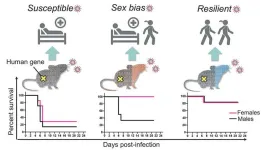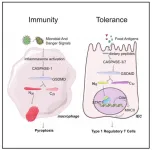(Press-News.org) A novel catalysis scheme enables chemical reactions that were previously virtually impossible. The method developed at the University of Bonn is also environmentally friendly and does not require rare and precious metals. The researchers recorded the exact course of the catalysis in a kind of high-speed film. They did this using special lasers that can make processes visible that last only fractions of a billionth of a second. The results allow them to further optimize the catalyst. They have been published in the international edition of the renowned journal Angewandte Chemie.
Let’s say you are playing mini golf. There is a small hill on the course that the golf ball has to overcome in order to roll into the hole behind it. To do this, you need to hit it with enough force. Otherwise, it will not make it over the obstacle, but will roll back towards you.
It is similar for many chemical reactions: In order for them to proceed, you first have to supply them with enough energy. A catalyst reduces this activation energy. To stay in the picture: It levels the hill a bit so the ball needs less momentum to roll over it. The reaction is therefore easier and faster. “Some reactions are even only made possible by the use of catalysts,” explains Prof. Dr. Andreas Gansäuer.
Titanium instead of precious metals
The researcher works at the Kekulé Institute of Organic Chemistry and Biochemistry at the University of Bonn. He has been working for years on how to simplify the production of certain carbon compounds. The use of catalysts is usually the means of choice here. The problem: Often, the “reaction accelerators” consist of rare and precious metals such as platinum, palladium, or iridium.
“We usually use titanium compounds instead,” says Gansäuer. “This is because titanium is one of the most abundant elements in the earth’s crust and is also completely non-toxic.” However, titanium-based catalysts often still need a companion to be able to accelerate chemical reactions. Most often, this is also a metal. It activates the catalyst, (unlike the latter) is consumed in the reaction, and generates by-products as waster.
“This is both costly and not very sustainable,” emphasizes Gansäuer’s colleague Prof. Dr. Peter Vöhringer of the Clausius Institute for Physical and Theoretical Chemistry at the University of Bonn. “However, there have been attempts for some time to achieve this activation in a different way: By irradiating the catalyst with light. We have now implemented this idea. At the same time we filmed, in a sense, the processes that occur during activation and catalysis.”
Lasers create “lightning storm”
The “high-speed camera” used by the researchers was a spectrometer - this is a complex instrument that can be used to determine what a molecule looks like at a certain point in time. For this to work, you also need a flash. To do this, the researchers use a laser that switches on and off continuously. The bright moments each last only a few hundred femtoseconds (a femtosecond is the millionth part of a billionth of a second). The catalysis process is thus broken down into a sequence of individual images. “This allows us to visualize ultrafast processes,” says Vöhringer, who is a specialist in this method.
Not all molecules can be filmed easily. “We therefore had to make some modifications to the titanium catalyst we usually use,” says Gansäuer. The experiments show that the compound can be activated by light and is then able to catalyze a specific form of redox reactions. In redox reactions, electrons are passed from one reactant to the other. “This process is facilitated by the activated catalyst,” Gansäuer explains. “This allows us, for example, to produce compounds that serve as starting materials for many important drugs.”
Greedy for electrons
The “high-speed film” documents exactly what happens during light activation. “Electrons resemble a compass needle that points in a certain direction,” says Jonas Schmidt, who is doing his doctorate in Prof. Vöhringer’s research group. “This spin changes as a result of irradiation.” Figuratively speaking, the titanium compound thus becomes “greedier” to accept an electron. When it does, it starts the redox reaction.
“Thanks to the insights we have gained with our method, we can now further optimize the catalyst,” explains Vöhringer, who, like Prof. Gansäuer, is a member of the Transdisciplinary Research Area “Matter” at the University of Bonn. It is already possible to use it to carry out chemical reactions that were hardly feasible before. The success is also an expression of fruitful cooperation between organic chemistry on the one hand and laser and molecular physics on the other, Vöhringer emphasizes: “Our study shows the fruits that can come from collaboration between two research groups with completely different methodological backgrounds.”
Funding:
The study was funded by the German Research Foundation (DFG) and the Manchot Foundation.
Publication: Jonas Schmidt, Luis I. Domenianni, Marcel Leuschner, Andreas Gansäuer und Peter Vöhringer: Observing the Entry Events of a Titanium-Based Photoredox Catalytic Cycle in Real Time; Angewandte Chemie; DOI: 10.1002/anie.202307178; Internet: https://onlinelibrary.wiley.com/doi/10.1002/anie.202307178
Media contact:
Prof. Dr. Peter Vöhringer
Clausius Institute for Physical and Theoretical Chemistry
University of Bonn
Telephone: +49 228 737050
E-mail: pvoehr@uni-bonn.de
Prof. Dr. Andreas Gansäuer
Kekulé-Institut für Organische Chemie und Biochemie
University of Bonn
Telephone: +49 228 732800
E-mail: andreas.gansaeuer@uni-bonn.de
END
Researchers “film” novel catalyst at work
Catalysis scheme developed at the University of Bonn is inexpensive, sustainable, and effective
2023-08-11
ELSE PRESS RELEASES FROM THIS DATE:
Mosquito hearing could be targeted by insecticides
2023-08-11
Specific receptors in the ears of mosquitoes have been revealed to modulate their hearing, finds a new study led by researchers at UCL and University of Oldenburg. Scientists say, this discovery could help develop new insecticides and control the spread of harmful diseases, such as malaria.
The ability of male mosquitoes to hear female mosquitoes is a crucial requirement for their reproduction. As a result, the finding could help develop novel insecticides or mating disruptors to prevent mosquito-borne diseases like malaria, dengue, and yellow fever
In the study, published in Nature Communications, ...
A quantum leap in mechanical oscillator technology
2023-08-11
Over the past decade, scientists have made tremendous progress in generating quantum phenomena in mechanical systems. What seemed impossible only fifteen years ago has now become a reality, as researchers successfully create quantum states in macroscopic mechanical objects.
By coupling these mechanical oscillators to light photons - known as “optomechanical systems”-, scientists have been able to cool them down to their lowest energy level close to the quantum limit, “squeeze them” to reduce their vibrations even further, and entangle them with each other. These advancements have opened up new opportunities in quantum sensing, ...
USTC develops new catalysts for CO2 electroreduction
2023-08-11
As a crucial part of Carbon Capture, Utilization, and Storage (CCUS) technology, CO2 reduction reaction (CO2RR) to carbon-based fuels and chemicals presents broad application prospects in renewable energy storage and CO2 negative emission. Recently, a team led by Prof. SONG Li and Associate Researcher HE Qun from the National Synchrotron Radiation Laboratory of the University of Science and Technology of China (USTC) of the Chinese Academy of Sciences (CAS) put forth a novel understanding of the mechanism of CO2RR on the nickel (Ni) single-atomic sites. Their study, titled "Asymmetric ...
Variable patient responses to SARS-CoV-2 infection are mimicked in genetically diverse mice
2023-08-11
Researchers at The Jackson Laboratory have created a panel of genetically diverse mice that accurately model the highly variable human response to SARS-CoV-2 infection. Together with collaborators at NIH’s Rocky Mountain Laboratories, the team uncovered differences in the innate immune and regulated proinflammatory responses, the timing and strength of which are associated with disease severity. Moving forward, the diverse mouse strains will allow scientists to model patient variation in COVID-19 ...
Researchers reveal Gasdermin D's hidden power in maintaining food tolerance
2023-08-11
A research team led by Prof. ZHU Shu from the University of Science and Technology of China (USTC) of the Chinese Academy of Sciences (CAS) illustrated the role of Gasdermin D (GSDMD) protein in immunity tolerance to food in the small intestine. The study was published in Cell.
GSDMD, an executioner protein of cell pyroptosis, has garnered widespread attention. When cells are stimulated by pathogen-associated molecular patterns (PAMPs) or damage-associated molecular patterns (DAMPs), the signaling receptors within the cells activate caspase-1/4/5/8/11, leading to the N-terminal cleavage of GSDMD and ...
Researchers discover quasar-driven superbubble pairs
2023-08-11
A team led by Prof. LIU Guilin and Prof. HE Zhicheng from the University of Science and Technology of China (USTC) of the Chinese Academy of Sciences (CAS) discovered superbubble pairs generated by quasar-driven outflows of three red quasars for the first time. This study was published in Science Advances.
The observed number of massive galaxies is significantly lower than the prediction of the current galaxy evolution theory, thus certain mechanism is needed to suppress star formation and modulate the growth of the galaxy. To bridge the gap between theory and observation, an outflow mechanism where a galaxy nucleus drives a massive amount of gas into intergalactic ...
Researchers reveal mechanism triggering Arctic daily warming
2023-08-11
Prof. REN Baohua and his team from the School of Earth and Space Sciences, the University of Science and Technology of China (USTC) of the Chinese Academy of Sciences (CAS), uncovered the connection between Arctic daily warming and the equator region as well as Atlantic storms. The series of studies have been published in npj Climate and Atmospheric Science, Environmental Research Letters, and Advances in Atmospheric Sciences.
As one of the coldest places where the average winter temperature is -30℃, the Arctic temperature has reached the melting point several times, for instance, in late December 2015 and 2022. Those Artic daily warming events ...
USTC unveils high-precision flatness measurement for cryogenic mosaic focal plane arrays
2023-08-11
A research team led by Professor WANG Jian, the deputy chief designer of the Wide Field Survey Telescope(WFST)and a faculty member of the State Key Laboratory of Nuclear Detection and Nuclear Electronics of the School of Physics, University of Science and Technology of China (USTC) of the Chinese Academy of Sciences(CAS), carried out the key technology of the main focus camera. The results were published in IEEE Transactions on Instrumentation and Measurement in July ...
USTC achieved dynamic imaging of interfacial electrochemistry
2023-08-11
The research team led by Prof. LIU Xianwei from the Department of Environmental Science and Engineering of University of Science and Technology of China (USTC) of the Chinese Academy of Science (CAS) has made progress in the dynamic imaging of interfacial electrochemistry. The results were published in Nature Communications under the title of "Dynamic Imaging of Interfacial Electrochemistry on Single Ag Nanowires by Azimuth-modulated Plasmonic Scattering ...
Femtosecond laser technique births "dancing microrobots": USTC's breakthrough in multi-material microfabrication
2023-08-11
A research team led by Prof. WU Dong from the University of Science and Technology of China (USTC) of the Chinese Academy of Sciences (CAS) proposed a femtosecond laser 2-in-1 writing multi-material processing strategy to fabricate micromachined joints composed of temperature-sensitive hydrogels and metal nanoparticles, and developed multi-jointed humanoid micromachines with multiple deformation modes (>10). The results were published in Nature Communications.
In recent years, femtosecond laser two-photon polymerization, as a true three-dimensional fabrication technique ...
LAST 30 PRESS RELEASES:
CHANGE-seq-BE finds off-target changes in the genome from base editors
The Journal of Nuclear Medicine Ahead-of-Print Tip Sheet: January 2, 2026
Delayed or absent first dose of measles, mumps, and rubella vaccination
Trends in US preterm birth rates by household income and race and ethnicity
Study identifies potential biomarker linked to progression and brain inflammation in multiple sclerosis
Many mothers in Norway do not show up for postnatal check-ups
Researchers want to find out why quick clay is so unstable
Superradiant spins show teamwork at the quantum scale
Cleveland Clinic Research links tumor bacteria to immunotherapy resistance in head and neck cancer
First Editorial of 2026: Resisting AI slop
Joint ground- and space-based observations reveal Saturn-mass rogue planet
Inheritable genetic variant offers protection against blood cancer risk and progression
Pigs settled Pacific islands alongside early human voyagers
A Coral reef’s daily pulse reshapes microbes in surrounding waters
EAST Tokamak experiments exceed plasma density limit, offering new approach to fusion ignition
Groundbreaking discovery reveals Africa’s oldest cremation pyre and complex ritual practices
First breathing ‘lung-on-chip’ developed using genetically identical cells
How people moved pigs across the Pacific
Interaction of climate change and human activity and its impact on plant diversity in Qinghai-Tibet plateau
From addressing uncertainty to national strategy: an interpretation of Professor Lim Siong Guan’s views
Clinical trials on AI language model use in digestive healthcare
Scientists improve robotic visual–inertial trajectory localization accuracy using cross-modal interaction and selection techniques
Correlation between cancer cachexia and immune-related adverse events in HCC
Human adipose tissue: a new source for functional organoids
Metro lines double as freight highways during off-peak hours, Beijing study shows
Biomedical functions and applications of nanomaterials in tumor diagnosis and treatment: perspectives from ophthalmic oncology
3D imaging unveils how passivation improves perovskite solar cell performance
Enriching framework Al sites in 8-membered rings of Cu-SSZ-39 zeolite to enhance low-temperature ammonia selective catalytic reduction performance
AI-powered RNA drug development: a new frontier in therapeutics
Decoupling the HOR enhancement on PtRu: Dynamically matching interfacial water to reaction coordinates
[Press-News.org] Researchers “film” novel catalyst at workCatalysis scheme developed at the University of Bonn is inexpensive, sustainable, and effective






